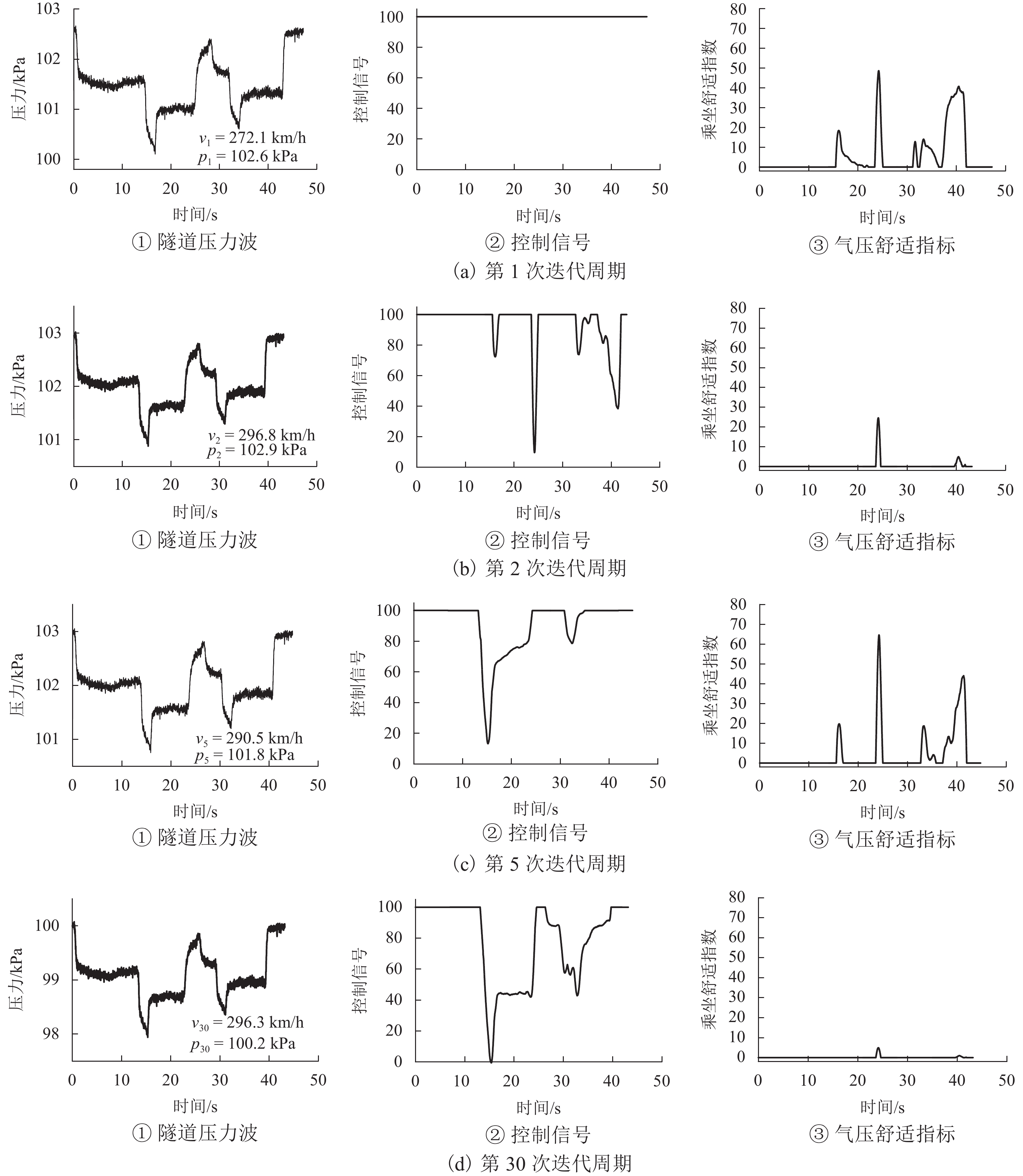Iterative Learning Control of Interior Pressure Under Excitation of Tunnel Pressure Wave with Fixed Form
-
摘要:
同一列车重复通过同一隧道时所产生隧道压力波激扰具有形态相似、变尺度变幅值的特性. 针对现有控制策略未考虑这一定形态特性的问题,提出一种基于高阶反馈遗忘迭代学习的控制方法. 首先,建立高速列车车内外气压传递数学模型,并利用实测车内外压力数据进行修正与验证;其次,通过控制列车通风设备的阀门来减缓车内压力变化,提出阶反馈遗忘迭代学习控制算法,并设计变幅值和变尺度处理方法;最后,利用实测压力波生成一组定形态的随机压力波,并进行仿真分析. 仿真结果表明:在重复定形态的隧道压力波激扰下,高阶反馈遗忘迭代学习控制算法能够使车内压力在第8个迭代周期后1 s变化率基本收敛到200 Pa/s以下,而且均方根误差也在第4个迭代周期后降低到15.0000%以下.
Abstract:The tunnel pressure wave excitation generated when the same train passes through the same tunnel repeatedly has the characteristics of similar forms, variable scales, and variable amplitudes. Since the current control strategies do not take into account this fixed form, an iterative learning control method based on higher-order feedback forgetting was proposed, so as to control the interior pressure fluctuation under the disturbance of the pressure wave of the tunnel with a fixed form. First, a mathematical model of air pressure transmission inside and outside high-speed trains was established, and the measured pressure data inside and outside the train were used for correction and verification. Secondly, pressure changes in the train were mitigated by controlling the valve of the train’s ventilation. The iterative learning control algorithm based on higher-order feedback forgetting was proposed, and the variable amplitude and variable scale processing methods were designed. Finally, a set of stochastic pressure waves with a fixed form was generated by using the measured pressure waves, and simulation analysis was carried out. The simulation results show that the iterative learning control algorithm based on higher-order feedback forgetting can make the pressure inside the train converge to below 200 Pa/s within 1 s after the 8th iteration period, and the RMSE value is reduced to below 15.0000% after the 4th iteration period under the excitation of the tunnel pressure wave with repetitive fixed form.
-
在高速轨道交通领域,司乘人员的气压舒适性是重要的研究内容[1]. 在列车高速进入隧道时,由于车-隧耦合作用,在隧道内形成剧烈的交变的隧道压力波动(即隧道压力波)[2]. 当车内压力波动达到一定程度时,会引起旅客耳鸣、耳痛、头晕等不同程度的不适感,直接影响乘客乘坐时的舒适性. 目前,国内外学者从主动控制和被动控制两方面入手,分别对换气风道内的换气风机以及压力保护阀进行控制[3]. 在现有的实践中,日本、德国以及我国均采用了固定时长关闭换气风道压力保护阀的被动控制方法,在列车进入隧道时,通过关闭一段时间换气风道的压力保护阀,阻碍车内外压力的传递,进而抑制车内压力波动[4]. 随着西部山区高速铁路的兴建,我国高速列车的运行环境出现了长大隧道的特征,给车内压力波动控制带来新的挑战,传统的固定时长关闭换气风道的控制方法难以解决车内压力舒适性与空气质量之间的矛盾. 因此,对车内压力波动控制方法的研究显得尤为重要.
迭代学习控制(iterative learning control,ILC)无需建立系统精确模型,直接利用过去运行的周期性重复数据来提高当前周期的控制性能[5]. 迭代学习由日本学者Uchiyama[6]1978年在研究机械手臂重复运动控制中提出;然后,Arimoto等[7]利用机器人系统模拟人类学习技能,促进了该理论成为控制理论的一个重要分支. Luo等[8]针对稳态负荷的电力系统谐波电流干扰,设计了比例积分(proportional-integral,PI)型的实时迭代学习控制器,通过使用遗忘因子增强了系统鲁棒性. 研究证明,迭代学习控制是处理这类具有周期性特征任务的有效方法.
但是,同一列车按固定编组和运行图重复通过同一隧道时,由于受运行速度波动和环境气象因素(气压和风速等)的随机干扰,产生的隧道压力波不具有严格周期性,而是其幅值和周期均有摄动的定形态压力波. 然而,传统的迭代学习控制算法不仅未考虑这一特征,而且难以解决变幅度、变尺度问题. 针对这一问题,需要利用与之相对应的迭代学习控制策略.
国内外学者在随机迭代学习控制上已有一定的研究. Saab等[9]针对连续时间非线性系统考虑了当跟踪目标缓变时对迭代学习控制性能的影响,提出了含有遗忘因子的更新律. Shen等[10]提出了一种随机迭代变长离散非线性系统的迭代学习控制,并进行了逐点意义下的收敛性分析. 王晶等[11]研究了离散线性系统批次长度随机变化的反馈辅助比例微分(proportional differential,PD)型量化迭代学习控制问题,给出了两种量化方案. 但是,目前随机迭代学习控制研究还未应用于车内压力波动控制方面. 在高速列车重复性地通过同一隧道时,产生的定形态压力波的时间尺度在迭代域中随机变化. 因此,需要设计算法解决变幅值、变尺度问题,使之满足传统迭代学习的要求,可以充分利用过去的控制经验,提高性能.
针对定形态隧道压力波激扰下的车内压力控制,本文首先分析高速列车内外气压传递路径,建立气压传递数学模型,利用车内外压力波实测数据对模型进行验证与修正. 然后,通过控制列车换气风道压力保护阀的开闭及开度抑制车内的压力波动,并引入收敛速度快、控制精度高的高阶遗忘学习律,设计算法解决变幅值、变尺度的问题. 最后,利用实测压力波生成随机定形态隧道压力波,进行仿真分析. 该算法不仅能有效地降低定形态隧道压力波激扰下车内压力波动,还较传统的比例(proportional,P)型迭代学习算法具有更好的收敛效果.
1. 高速列车车内外气压传递数学模型
1.1 数学模型建立
高速列车通过隧道时,车内外气压传递路径主要包括2种:车体缝隙和换气风道,其中,换气风道又包括新风风道和废排风道. 本文在文献[12]的基础上,充分考虑空气流动所引起的车内气体质量变化,基于质量守恒定律以及理想气体状态方程,建立多因素耦合作用下的车内外气压传递模型.
高速列车内气压传递的状态空间方程为
\left\{ \begin{gathered} {p_k}(n + q) = {p_k}(n) + {{\boldsymbol{B}}_k}(n){{\boldsymbol{u}}_k}(n), \\ {y_k}(n) = {p_k}(n), \\ \end{gathered} \right. (1) 式中: {p_k}(n) 和 {y_k}(n) 分别为第k次迭代中离散时间n时的车内压力和系统输出; {{\boldsymbol{B}}_k}(n) 为输入矩阵,如式(2)所示;q为延迟系数,q \in {\mathbb{N}},q与采样时间间隔 \Delta t 的乘积 q\Delta t 为延迟时间; {{\boldsymbol{u}}_k}(n) 为系统的控制信号矩阵,如式(3)所示.
{{\boldsymbol{B}}_k}(n){\text{ = }}[\Delta {p_{1k}}(n)\;{\text{ }}\Delta {p_{2k}}(n)\;{\text{ }}\Delta {p_{3k}}(n)], (2) {{\boldsymbol{u}}_k}(n) = {[1{\text{ }}C{v_k}(n){\text{ }}C{v_k}(n)]^{\text{T}}}, (3) 式中: \Delta {p_{ik}}(n) 为所有车内外气压传递路径引起的气压变化,i = 1,2,3,依次表示气压变化由气密缝隙、新风风道和废排风道引起,如式(4)所示[13];vk(n)为第k次迭代中的列车车速;C为系数, C{v_k}(n) \in [0,1] .
uk(n)矩阵中第2项和第3项分别是新风风道和废排风道中风量调节阀的开度(即阀门的打开程度).
\qquad\qquad\qquad\quad \Delta {p_{1k}}(n){\text{ = }}\left\{ {\begin{array}{*{20}{l}} {\dfrac{{S \sqrt {2RT[p_k^2(n) - {p_k}(n){p_{{\rm{tun}},{k}}}(n)]} }}{{f{V_k}(n)}}},\quad {p_k}(n) \geqslant {p_{{\rm{tun}},k}}(n),\\ \dfrac{{S \sqrt {2RT[{p_{{\rm{tun}},k}}{{(n)}^2} - {p_k}(n){p_{{\rm{tun}},k}}(n)]} }}{{f{V_k}(n)}}, \quad {p_k}(n)<{p_{{\rm{tun}},k}}(n), \end{array}} \right. \tag{4a} \qquad\qquad \left\{ \begin{gathered} \Delta {p_{2k}}(n) = \frac{{{p_{{\rm{tun,}}k}}(n)}}{{3\,600f{V_k}(n)}}\left[ {680.15 + } {\sqrt {462\,604.02 + 183.82\left( {1\,700 + {p_{{\rm{tun,}}k}}(n) - {p_k}(n)} \right)} } \right], \\ \Delta {p_{3k}}(n) = \frac{{{p_k}(n)}}{{3\,600f{V_k}(n)}}\left[ {680.15 + } {\sqrt {462\,604.02 + 183.82\left( {1\,700 + {p_k}(n) - {p_{{\rm{tun,}}k}}(n)} \right)} } \right], \\ \end{gathered} \right. \tag{4b} 式中: {p_{{\rm{tun,k}}}}(n) 为第k次迭代车外隧道内的压力;R为摩尔气体常数,{\text{J}} /{({\text{mol}} {\text{•}} {\text{K)}}};T为车内空气温度,K;S为当量泄露面积,与车内外压差相关[14];f为测试系统的采样频率; {V_k}(n) 为第k次迭代车体体积,与车内外压差间的关系如式(5)所示[15].
{V_k}(n) = {V_0}\left[ {1 + 4.423 \times {{10}^{ - 4}}\left( {{p_k}(n) - {p_{{\rm{tun,}}k}}(n)} \right)} \right], (5) 式中:V0为初始时刻的车体体积,m2.
将式(2)~(5)代入式(1),即可得到高速列车车内外气压传递模型.
1.2 模型验证
已知一般情况下,车内压力的初始值会比车外压力高出30 Pa,某型高速列车车厢体积为135.5 m3,车内室温为20 ℃,标准大气压为101 325 Pa. 将某次现场试验测得的尾车压力波作为激扰,代入车内外气压传递模型中,估计车内气压 \hat{p}_{k}(n + q) . 然后,将仿真出的车内压力波{\hat p_k}与实测的车内压力{p_k}对比,修正系统模型,确定延迟系数 q 的值,本文仿真使用的采样时间间隔为0.001 s.
为确定车内外气压传递模型中的最优延迟时间,采用平均绝对百分比误差(mean absolute percentage error,MAPE)来衡量修正精度,表示为
e_{\text{MAPE }} =\frac{1}{n}\sum\limits_{g = 0}^n {\frac{{\left| {{{\hat p}_k}(g) - {p_k}(g)} \right|}}{{{p_k}(g)}}} \times 100\text{%} \text{,} (6) 式中: {\hat p_k}(g) 和 {p_k}(g) 分别为第k次迭代中第g时刻车内气压仿真数据和实测数据.
表1是不同值下模拟车内压力曲线和模拟与实测车内气压的MAPE值,可以看出,尾车的MAPE值在延迟时间q\Delta t=0.003 s时最小,为0.20%. 且从图1中可知,当延迟时间为0.003 s时,车内仿真气压曲线与实测气压曲线基本一致,更加符合车内外气压传递的实际过程,因此,选择延迟系数q{\text{ = }}3.
表 1 模拟与实测车内气压的MAPE值Table 1. MAPE values of simulated and measured pressure inside the trainq 1 2 3 4 MAPE/% 0.37 0.31 0.20 0.25 2. 车内压力波动控制算法设计
高速列车车内压力控制系统框图如图2所示. 图中:{e_k}(n)、\mathop e\nolimits_k^* (n)分别为第k次迭代中离散时间n时的误差、定尺度处理后的误差;j \in \left[ {1,k} \right] ,且j \in \mathbb{N} ;{n_{\text{d}}}为期望的试验时间尺度;{u_{k + 1}}(n)、\mathop u\nolimits_{k + 1}^* (n)分别为第k+ 1次迭代中离散时间n的控制量、定尺度处理后控制量;Jk(n)为气压舒适指数(气压的1 s变化率),即1 s内气压的最大值与最小值之差(式(7)).
{J_k}(n) = \mathop {\max }\limits_{t \in \kappa } \{ {p_k}(t)\} - \mathop {\min }\limits_{t \in \kappa } \{ {p_k}(t)\} , (7) 式中:\kappa {\text{ = \{ }}t|t = n,n + 1,\cdots,n + f - 1{\text{\} }}.
给定的气压舒适度指标为理想值,控制系统的输出是车内气压,控制对象是列车的空调换气系统,执行器是换气风道的阀门,不同阀门开度下控制系统的响应特征也不相同,开度越大,车内压力变化越大[14]. 因此,其控制原理为:通过气压传感器实时对车内压力进行检测,算得乘坐舒适指数,与理想乘坐舒适指数进行比较,得到控制误差;利用迭代学习控制器,对换气风道的阀门定位器控制信号进行修正,从而调节阀门开度,将车内气压控制在乘客感受舒适的范围之内.
同一列车通过同一隧道产生的定形态隧道压力波的时间尺度和幅度在迭代域中不断变化,武广线某次列车以不同速度v通过海棠隧道的隧道压力波数据如图3所示. 而传统的迭代学习控制要求任务严格可重复,即每次迭代周期的时间尺度、波形幅度以及初始值必须严格相同. 因此,在进行迭代学习控制前,要先解决隧道压力波变幅值和变尺度的问题,使之满足经典迭代学习控制中控制目标必须完全相同的要求.
2.1 变幅值问题
车内压力波动是由隧道压力波激扰产生的,其幅值随隧道压力波幅值的变化而不同,将不同幅值的车内压力波作为控制目标不能满足迭代学习控制算法中固定目标的要求. 因此,放弃幅值不固定的车内压力波作为控制目标,转变为将气压舒适度评估指标作为新的控制目标[16],如式(8)所示.
{J_k}(n) = \left\{ \begin{gathered} {J_k}(n) - {J_{\rm{d}}}(n),\quad{J_k}(n) > {J_{\rm{d}}}(n), \\ 0,\quad{\text{ }}{J_k}(n) \leqslant {J_{\rm{d}}}(n) , \\ \end{gathered} \right. (8) {J_{\rm{d}}}(n) = \max {\text{\{ }}{J_{{\text{com}}}},{J_{\text{c}}}(n){\text{\} }}, (9) 式中:{J_{\rm{d}}}(n)为乘客舒适的期望气压1 s变化率的最大值, {J_{\text{c}}}(n) 为所有风道关闭时的气压变化率, {J_{{\text{com}}}} 为设置的舒适期望气压变化率.
根据列车车内气压变化的舒适度标准,气压变化率小于200 Pa/s认为舒适度等级为优[17],此时人耳非常舒适,因此,确定期望舒适的气压变化率为 {J_{{\text{com}}}} = 200{\text{ Pa/s}} .
理想情况下希望车内压力处于舒适状态,即期望气压舒适指数{J_{\text{d}}}(n){\text{ = }}0,则气压舒适指数误差为
{e_k}(n) = {J_{\text{d}}}(n) - {J_k}(n) = - {J_k}(n). (10) 变幅值的过程示意如图4所示,3组定形态隧道压力波信号具有不同的幅值,经过控制目标转换后,得到定幅值的乘坐舒适指数目标,解决了变振幅这一问题,图中, {n}_{1}、{n}_{2}、{n}_{3} 为3组压力波的时间尺度.
2.2 变尺度问题
变尺度问题分为误差定尺度处理和控制信号变尺度处理两部分.
设{n_{\rm{d}}}为期望的试验时间尺度,根据高速列车固定编组按照最慢运行车速通过隧道的情况来确定,其值在迭代域中不断变化,满足
{n_k} \leqslant {n_{\rm{d}}}, (11) 式中:{n_k}为第k次迭代的试验时间尺度.
1) 误差定尺度处理
由于列车每次通过隧道的试验时间尺度不同,首先需要对误差进行修正,使之与期望的试验时间尺度一致,满足迭代学习的要求.
假设列车以进入隧道前一刻的车速匀速通过隧道,则通过隧道的时间尺度与车速的关系为
{n_k}/{n_{\rm{d}}} = {v_{\rm{d}}}/{v_k}, (12) 式中: {v_{\rm{d}}} 为列车通过隧道的期望最慢车速.
根据本次列车进入隧道时的试验时间尺度{n_k}和列车出隧道后计算所得的气压舒适指数误差 {e_k}(n) ,经过映射,计算本次的跟踪误差为
e_k^*(n) = {e_k} \;{\rm{round}}\left(n \frac{{{n_{\rm{d}}}}}{{{n_k}}}\right),\quad n \in [0,{n_k}], (13) 式中:round(·)表示四舍五入取整,以保证 e_k^*(n) 的每次映射在 {e_k}(n) 中能有效取值.
在将跟踪误差信号尺度拉伸到期望试验时间尺度{n_{\rm{d}}}后,会造成{n_{\rm{d}}} - {n_k}个信号的缺失,此时搜索出缺失的信号,逐一地利用前后已有的信号取均值进行填充,即
e_k^*({n^*}){\text{ = }}\frac{1}{2}\left[ {e_k^*({n^*} - 1) + e_k^*({n^*} + 1)} \right], (14) 式中: {n^*} 为缺失的跟踪误差信号时间点.
因此,经过上述定尺度处理后,每次列车通过此隧道的跟踪误差 e_k^*(n) 的长度为定值{n_{\rm{d}}}.
2) 控制信号变尺度处理
将历史数据中的跟踪误差 e_j^*(n) 和控制量 u_j^*(n) ,代入迭代学习控制器中计算,得到第k + 1次迭代的跟踪控制量 u_{k + 1}^*(n) . 然后,对控制信号进行变尺度处理得到 {u_{k + 1}}(n) ,使之与第k + 1次迭代的时间尺度相匹配.
同样地,根据本次迭代列车进入隧道前一刻的车速 {v_{k{\text{ + }}1}} 来映射得到第k + 1次迭代的控制量:
\begin{split} &{u_{k + 1}}\left(n\right) = u_{k + 1}^{\text{*}}\;{\text{round}}\left(n \frac{{{n_{k{{ + }}1}}}}{{{n_{\rm{d}}}}}\right) =\\ &\quad u_{k + 1}^{\text{*}}\;{\text{round}}\left(n \frac{{{v_{\rm{d}}}}}{{{v_{k{{ + }}1}}}}\right),\quad n \in [0,{n_{\rm{d}}}]. \end{split} (15) 式(15)中四舍五入取整用以保证 {u_{k + 1}}(n) 的每次映射在 u_{k + 1}^{\text{*}}(n) 中能有效取值.
同样地,在将跟踪误差信号的尺度压缩到期望试验时间尺度后 ,会造成{n_{\rm{d}}} - {n_{k{\text{+}}1}}个信号的多余,但是通过近似取整运算会使多余的控制信号被相邻后一个控制信号所覆盖. 因此,变尺度所得到控制信号 {u_{k + 1}}(n) 的时间尺度变为第k + 1次的试验时间尺度{n_{k + 1}},这样就解决了变尺度问题.
2.3 迭代学习控制算法
在解决了变幅值、变尺度问题之后,已经符合了传统迭代学习控制任务严格可重复的条件,下面介绍控制器的设计.
迭代学习控制算法是一种在重复系统中跟踪期望轨迹的控制方法,其主要策略是改进一次试验的输入,以便在下一次试验中提高系统性能,被广泛应用于实际工程中[4]. 因此,针对车内外气压传递系统这种离散非线性系统,引入了高阶P型反馈迭代学习控制算法,不仅能够充分将以前的控制数据应用到系统中,相比于传统P型迭代学习控制,具有较快的收敛速度[18],其迭代学习律为
u_{k + 1}^*(n) = u_k^*(n) + \sum\limits_{j = 1}^N { {{\alpha _j}e_{k - j + 1}^{\text{*}}(n)} } , (16) 式中:N是迭代学习律的阶数,且N \geqslant 1,当N{\text{ = }}1 时为P型迭代学习律;{\alpha _1}、{\alpha _2}、...、{\alpha _N}为反馈增益系数.
此外,由于系统存在扰动、量测噪声等干扰因素,在学习律中引入遗忘因子,构造高阶反馈遗忘因子学习律,可有效提高系统鲁棒性,加快仿真收敛速度,效果更理想[19]. 其迭代学习律为
u_{k + 1}^*(n) = \lambda u_k^*(n){\text{ + (}}1{{ - }}\lambda {\text{)}}u_{k - 1}^*(n) + \sum\limits_{j = 1}^N { {{\alpha _j}e_{k - j + 1}^{\text{*}}(n)} } , (17) 式中:\lambda 为遗忘因子,且满足\lambda \leqslant 1.
由于加入了遗忘因子,能够利用上一次迭代的数据,控制误差累积会随着迭代次数的增加越来越小,还可以解决传统迭代学习律对初始误差的敏感问题[20].
2.4 控制算法实现
控制算法的流程图如图5所示,设置迭代学习律的遗忘因子\lambda 和反馈增益系数 {\alpha _j} ,并设置系统控制信号的初值{{\boldsymbol{u}}_1}(n) = {[1\;1\;1]^{\text{T}}}(即风道全开). 在重复定形态隧道压力波的激扰下产生车内压力波,计算得出气压舒适指数{J_k}(n),经过误差定尺度处理后得到跟踪误差 e_k^*(n) . 再利用历史数据中跟踪误差和控制量,代入带有遗忘因子的高阶反馈迭代学习律中学习,算得第k{\text{ + }}1次迭代的控制量u_{k{\text{ + 1}}}^*(n). 最后对控制信号进行变尺度处理,得到与第k{\text{ + }}1次试验时间尺度相匹配的控制信号 {u_{k + 1}}(n) ,用于列车经过隧道时的换气风道的阀门控制.
3. 算法仿真分析
为验证所设计的带遗忘因子的高阶反馈迭代学习控制算法对车内压力波动控制的有效性,选取某次试验高速列车通过某一隧道时实际测得的车内外气压数据进行仿真模拟. 然而,同一列车以不同速度通过同一隧道时的试验数据是有限的. 因此,基于一组真实测试数据,产生一系列定形态随机隧道压力波,用于控制算法的仿真分析.
3.1 定形态随机压力波的生成
选取的实测信号如图6(a)所示,其试验时间尺度是45 s,即{n_0}{\text{ = }}45f,此时,列车通过隧道时的平均速度{v_0} = 290{\text{ km/h}}. 考虑列车通过隧道时其速度会使隧道压力波的尺度和幅值发生变化,设随机压力波的时间尺度和气压幅值{\psi _k} 分别为[1]
\left\{ \begin{gathered} {n_k} = \dfrac{{{v_0}}}{{{v_k}}} {n_0}, \\ {\psi _k} = {\left(\dfrac{{{v_k}}}{{{v_0}}}\right)^2} {\psi _0}, \\ \end{gathered} \right. (18) 式中: {\psi _0} 为实测信号的气压幅值.
{v_k}是随机生成的车速,{v_k} \in [270,\; 310]{\text{ km/h}},则换算可得随机压力波的时间尺度{n_k}\in \left[42{\text{.1}}f,\;48{\text{.3}}f \right].
模拟信号的车速谱如图6(b)所示,生成的随机隧道压力波部分数据如图6(c). 设期望试验时间尺度{n_{\rm{d}}}{\text{ = }}50f,使用带有遗忘因子的3阶反馈迭代学习律,即N = 3,设遗忘因子\lambda {\text{ = }}0.8,反馈增益系数α1、α2、α3分别为 { {0.5、0.3、0.2} } . 利用MATLAB建立车内外压力传递模型,设置仿真步长为0.001 s,迭代次数为100次,对设计的控制算法进行仿真.
3.2 仿真分析
使用车内气压信号的1 s变化率的范数作为列车经过隧道时的舒适度评估指标衡量控制效果,定义为
{\left\| {{J_k}} \right\|_\infty } = \mathop {\max }\limits_{n \in [1,{n_k}]} \{ {J_k}(n)\} . (19) 图7为100次迭代后的仿真结果. 其中,设置传统控制(即定时开关风道控制策略)关闭风道的固定周期为16.6 s. 由图可知,相比于传统控制,使用高阶反馈迭代ILC控制算法控制后气质,1 s变化率范数显著降低,且从第8个迭代周期后1 s变化率范数基本收敛到200 Pa/s以下,即车内压力处于舒适状态,可以看出,此算法能够抑制空气压力变化率,对随机实测信号激扰下的车内压力波动控制也是有效的.
第1、2、5、30次迭代周期的隧道压力波、控制信号以及气压舒适指标仿真结果如图8所示. 可以看出,经过不断迭代与修正,第30次迭代周期时的气压舒适指标基本接近于0,即表示列车在通过隧道时的车内压力1 s变化率的范数基本处于200 Pa/s以下,说明此时车内已非常舒适.
使用均方根误差(root mean square error,RMSE)作为评估控制算法的控制精度参考标准,其值为
e_{\text{RMSE}}(k) = \sqrt {\frac{1}{{{n_k}}}\sum\limits_{j = 1}^{{n_k}} {{{\left( {e_k^*} \right)}^2}} }. (20) 对比3种控制方法的仿真结果(见图9)可以看出,使用高阶遗忘迭代和传统迭代控制算法的RMSE值数均随着迭代周期次数的增加而逐渐减小,且逐渐收敛0.
将图9中的部分峰值点坐标提取出来,汇总于表2中. 高阶遗忘迭代算法和传统P型迭代算法在第13个周期迭代周期的RMSE值分别是2.3886 Pa和6.2149 Pa,分别为第4周期RMSE值的13.1941%和26.3100%,高阶遗忘迭代算法改善效果更好. 且从第15次后才基本收敛到某一范围内,而传统P型迭代算法则到第34次左右才开始收敛. 上述结果表明,高阶遗忘迭代控制算法比传统P型迭代算法的收敛速度更快、控制精度更高.
表 2 参数坐标点Table 2. Coordinates of parameters算法 峰值点坐标 高阶遗忘 ILC (2, 18.1035)、(8, 11.3191)、(13, 2.3886) 传统 P 型 ILC (2, 23.6218)、(8, 20.7152)、(13, 6.2149) 因此,本文针对定形态隧道压力波激扰设计的高阶遗忘迭代控制算法,不仅能够解决传统控制算法不能解决的变幅值、变尺度问题,有效的降低车内压力波动,还相比于传统P型迭代学习算法具有更快的收敛速度和更高的控制精度. 总之,将该算法用于重复定形态隧道压力波激扰下车内压力控制,获得较好的控制效果.
4. 结 论
针对同一高速列车通过同一隧道时产生的隧道压力波具有定形态的特征,本文提出了一种基于高阶反馈遗忘迭代学习的控制方法. 通过模拟随机压力波进行仿真分析,得到以下结论:
1) 针对定形态的隧道压力波,将气压舒适指数作为控制目标,本文提出了一种基于迭代学习的控制方法,能充分利用列车在线路上行驶的历史数据.
2) 基于映射的思想,设计了误差定尺度—迭代学习—控制信号变尺度的算法,解决了定形态压力波时间尺度不一致的问题,而且对其他随机迭代变长系统的迭代学习控制应用提供参考.
3) 引入高阶遗忘迭代学习律,并利用生成的随机隧道压力波进行仿真,结果表明所提算法不仅能够有效的降低车内压力波动,能够使车内压力在第8个迭代周期后1 s变化率基本收敛到200 Pa/s以下,而且RMSE值也在第4个迭代周期后降低到15.0000%以下,具有更好的控制效果.
致谢:轨道交通运维技术与装备四川省重点实验室开放基金课题(2019YW003)的资助.
-
表 1 模拟与实测车内气压的MAPE值
Table 1. MAPE values of simulated and measured pressure inside the train
q 1 2 3 4 MAPE/% 0.37 0.31 0.20 0.25 表 2 参数坐标点
Table 2. Coordinates of parameters
算法 峰值点坐标 高阶遗忘 ILC (2, 18.1035)、(8, 11.3191)、(13, 2.3886) 传统 P 型 ILC (2, 23.6218)、(8, 20.7152)、(13, 6.2149) -
[1] 田红旗. 列车空气动力学[M]. 北京: 中国铁道出版社, 2007. [2] RICCO P, BARON A, MOLTENI P. Nature of pressure waves induced by a high-speed train travelling through a tunnel[J]. Journal of Wind Engineering and Industrial Aerodynamics, 2007, 95(8): 781-808. doi: 10.1016/j.jweia.2007.01.008 [3] 王宗昌. 主动式与被动式车内压力保护系统对比分析[J]. 铁道车辆,2017,55(6): 30-32,5.WANG Zongchang. Comparison analysis of the active and passive pressure protection systems inside cars[J]. Rolling Stock, 2017, 55(6): 30-32,5. [4] 李树典,周新喜. CRH2型200 km/h动车组车内压力波动控制研究[J]. 机车电传动,2009(2): 6-7.LI Shudian, ZHOU Xinxi. Study on the control of pressure fluctuation in CRH2 type 200 km/h EMUs[J]. Electric Drive for Locomotives, 2009(2): 6-7. [5] 孙明轩, 黄宝健. 迭代学习控制[M]. 北京: 国防工业出版社, 1999. [6] UCHIYAMA M. Formation of high-speed motion pattern of a mechanical arm by trial[J]. Transactions of the Society of Instrument and Control Engineers, 1978, 14(6): 706-712. doi: 10.9746/sicetr1965.14.706 [7] ARIMOTO S, KAWAMURA S, MIYAZAKI F. Bettering operation of robots by learning[J]. Journal of Robotic Systems, 1984, 1(2): 123-140. doi: 10.1002/rob.4620010203 [8] LUO A, XU X Y, FANG L, et al. Feedback-feedforward PI-type iterative learning control strategy for hybrid active power filter with injection circuit[J]. IEEE Transactions on Industrial Electronics, 2010, 57(11): 3767-3779. doi: 10.1109/TIE.2010.2040567 [9] SAAB S S, VOGT W G, MICKLE M H. Learning control algorithms for tracking “slowl” varying trajectories[J]. IEEE Transactions on Systems, Man, and Cybernetics, Part B (Cybernetics), 1997, 27(4): 657-670. doi: 10.1109/3477.604109 [10] SHEN D, ZHANG W, XU J X. Iterative Learning Control for discrete nonlinear systems with randomly iteration varying lengths[J]. Systems & Control Letters, 2016, 96: 81-87. [11] 王晶,周楠,王森,等. 随机变批次长度的反馈辅助PD型量化迭代学习控制[J]. 控制与决策,2021,36(10): 2569-2576.WANG Jing, ZHOU Nan, WANG Sen, et al. Feedback-assisted PD-type quantized iterative learning control with randomly iteration varying lengths[J]. Control and Decision, 2021, 36(10): 2569-2576. [12] 陈春俊,聂锡成,唐猛. 车外空气压力作用下的CRH2型动车组车内空气压力传递函数模型[J]. 中国铁道科学,2013,34(4): 84-88.CHEN Chunjun, NIE Xicheng, TANG Meng. Transfer function model of the air pressure inside CRH2 EMU under outside air pressure[J]. China Railway Science, 2013, 34(4): 84-88. [13] 冯永平. 隧道压力波作用下车内压力波动因素及动态气密性研究[D]. 成都: 西南交通大学, 2020. [14] CHEN C J, HE Z Y, FENG Y P, et al. Semi-empirical model of internal pressure for a high-speed train under the excitation of tunnel pressure waves[J]. Proceedings of the Institution of Mechanical Engineers, Part F: Journal of Rail and Rapid Transit, 2022, 236(7): 803-815. doi: 10.1177/09544097211042721 [15] 冯永平,陈春俊,陈仁涛. 基于流固耦合的隧道压力下车体变形对车内压力的影响分析[J]. 机车电传动,2021(3): 80-85.FENG Yongping, CHEN Chunjun, CHEN Rentao. Influence of vehicle body deformation on vehicle interior pressure under tunnel pressure based on fluid-solid coupling[J]. Electric Drive for Locomotives, 2021(3): 80-85. [16] HE Z Y, CHEN C J, WANG D W, et al. Iterative learning control of air pressure variation inside a high-speed train under the excitation of the tunnel pressure wave with a fixed-morphologic form[J]. Proceedings of the Institution of Mechanical Engineers, Part F: Journal of Rail and Rapid Transit, 2022, 236(6): 637-648. doi: 10.1177/09544097211032742 [17] SUZUKI H. Study on tinnitus caused by pressure fluctuation inside carriage[J]. Foreign Rolling Stock, 1999(5): 15-18. [18] KIM Y T, LEE H, NOH H S, et al. Robust higher-order iterative learning control for a class of nonlinear discrete-time systems[C]//IEEE International Conference on Systems, Man and Cybernetics. Washington D. C.: IEEE, 2003: 2219-2224. [19] WANG H B, DONG J A, WANG Y L. High order feedback-feedforward iterative learning control scheme with a variable forgetting factor[J]. International Journal of Advanced Robotic Systems, 2016, 13(3): 95.1-95.7. [20] YANG H, LI S M. PD-type ILC algorithm research with forgetting factor for a class of linear systems with multiple time delays[J]. Applied Mechanics and Materials, 2012, 220/221/222/223: 1125-1130. 期刊类型引用(0)
其他类型引用(1)
-





 下载:
下载:










 下载:
下载:


















